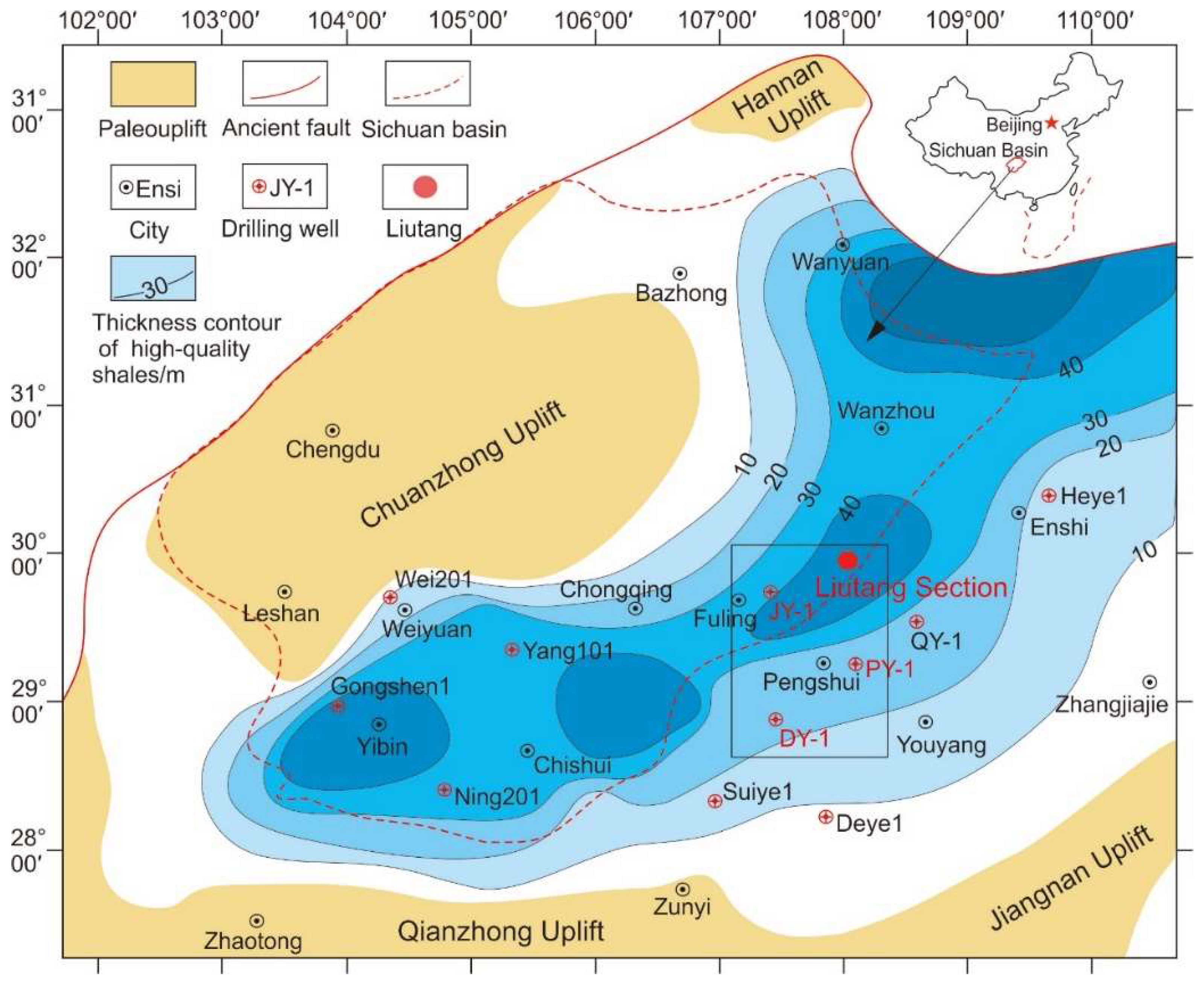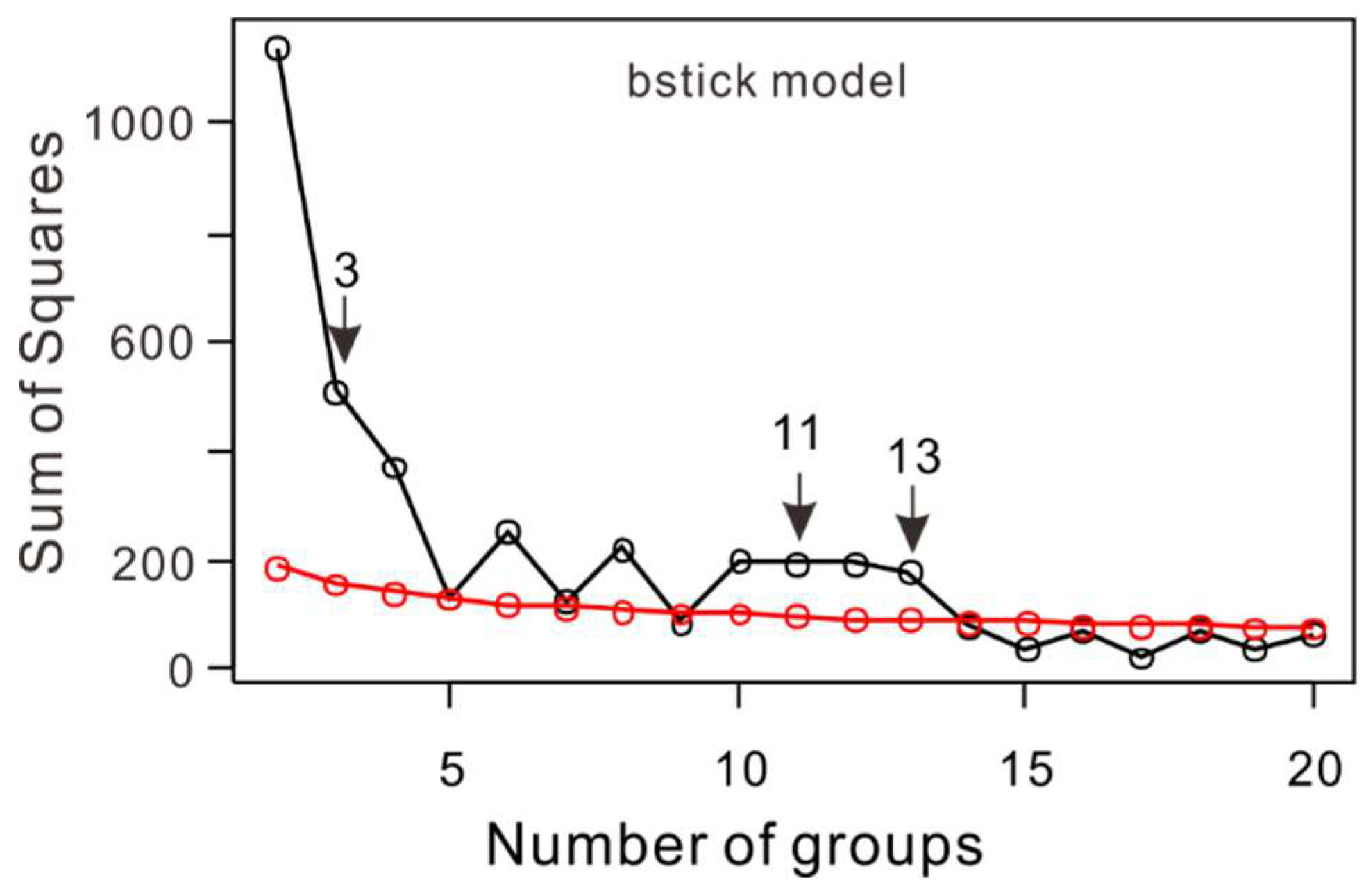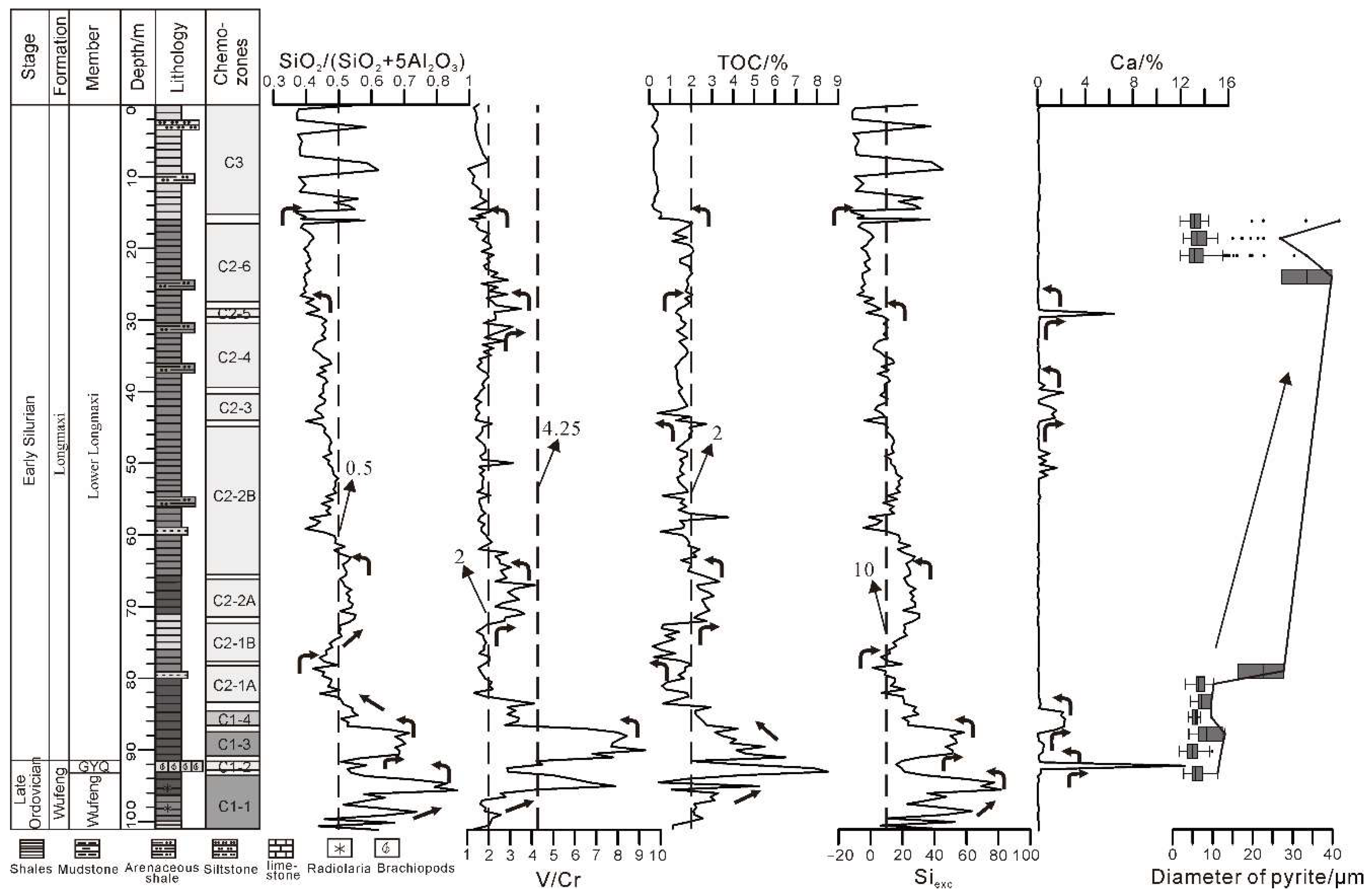Geochemical Characteristics and Chemostratigraphic Analysis of Wufeng and Lower Longmaxi Shales, Southwest China
Abstract
:1. Introduction
2. Geological Setting
3. Materials and Methods
3.1. Materials
3.2. Geochemical Analysis Method
3.3. Scanning Electron Microscopy (SEM)
3.4. Multivariate Statistics
4. Results
4.1. Geochemistry
4.2. Chemostratigraphy Zonation
5. Discussion
5.1. Sedimentary Geochemical Characteristics
5.1.1. Paleoproductivity
5.1.2. Terrigenous Inputs
5.1.3. Redox Conditions
5.2. Chemostratigraphy
5.2.1. Chemozones
5.2.2. Paleoenvironmental Significance of Chemozones
5.2.3. Regional Correlation
5.2.4. Identification of Sweet Spot
6. Conclusions
Supplementary Materials
Author Contributions
Funding
Data Availability Statement
Conflicts of Interest
References
- Curtis, J.B. Fractured shale–gas systems. AAPG Bull. 2002, 86, 1921–1938. [Google Scholar]
- Sano, J.L.; Ratcliffe, K.T.; Spain, D.R. Chemostratigraphy of the Haynesville shale. In Geology of the Haynesville Gas Shale in East Texas and West Louisiana; Hammes, U., Gale, J., Eds.; AAPG Memoir: Tulsa, OK, USA, 2013; Volume 105, pp. 137–154. [Google Scholar]
- Chen, L.; Lu, Y.C.; Jiang, S.; Li, J.Q.; Guo, T.L.; Luo, C.; Xing, F.C. Sequence stratigraphy and its application in marine shale gas exploration: A case study of the Lower Silurian Longmaxi Formation in the Jiaoshiba shale gas field and its adjacent area in southeast Sichuan Basin, SW China. J. Nat. Gas Sci. Eng. 2015, 27, 410–423. [Google Scholar] [CrossRef]
- Slatt, R.M.; Rodriguez, N.D. Comparative sequence stratigraphy and organic geochemistry of gas shales: Commonality or coincidence? J. Nat. Gas Sci. Eng. 2012, 8, 68–84. [Google Scholar] [CrossRef]
- Ratcliffe, K.T.; Wright, A.M.; Schmidt, K. Application of inorganic whole–rock geochemistry to shale resource plays: An example from the Eagle Ford Shale Formation, Texas. Sediment. Rec. 2012, 10, 4–9. [Google Scholar] [CrossRef]
- Turner, B.W. Utilization of Chemostratigraphic Proxies for Generating and Refining Sequence Stratigraphic Frameworks in Mudrocks and Shales. Ph.D. Thesis, University of Oklahoma Graduate College, Norman, OK, USA, 2016; pp. 1–98. [Google Scholar]
- Turner, B.W.; Tréanton, J.A.; Slatt, R.M. The use of chemostratigraphy to refine ambiguous sequence stratigraphic correlations in marine mudrocks. An example from the Woodford Shale, Oklahoma, USA. J. Geol. Soc. 2016, 173, 854–868. [Google Scholar] [CrossRef]
- Ramkumar, M. Chemostratigraphy: Concepts, Techniques, and Applications; Elsevier: Amsterdam, The Netherlands, 2015; pp. 1–432. [Google Scholar]
- Weissert, H.; Joachimski, M.; Sarnthein, M. Chemostratigraphy. Newsl. Stratigr. 2008, 42, 145–179. [Google Scholar] [CrossRef]
- Turner, B.W.; Molinares–Blanco, C.E.; Slatt, R.M. Chemostratigraphic, palynostratigraphic, and sequence–stratigraphic analysis of the Woodford Shale, Wyche Farm Quarry, Pontotoc County, Oklahoma. Interpretation 2015, 3, SH1–SH9. [Google Scholar] [CrossRef]
- Montero-Serrano, J.C.; Palarea–Albaladejo, J.; Martín–Fernández, J.A.; Martínez–Santana, M.; Gutiérrez–Martín, J.V. Sedimentary chemofacies characterization by means of multivariate analysis. Sediment. Geol. 2010, 228, 218–228. [Google Scholar] [CrossRef]
- Pearce, T.J.; Besly, B.M.; Wray, D.S.; Wright, D.K. Chemostratigraphy: A method to improve interwell correlation in barren sequences—A case study using onshore Duckmantian/Stephanian sequences (West Midlands, UK). Sediment. Geol. 1999, 124, 197–220. [Google Scholar] [CrossRef]
- Dypvik, H.; Harris, N.B. Geochemical facies analysis of fine-grained siliciclasics using Th/U, Zr/Rb and (Zr+Rb)/Sr ratios. Chem. Geol. 2001, 181, 131–146. [Google Scholar] [CrossRef]
- Kiipli, T.; Kallaste, T.; Nestor, V. Composition and correlation of volcanic ash beds of Silurian age from the eastern Baltic. Geol. Mag. 2010, 147, 895–909. [Google Scholar] [CrossRef]
- Algeo, T.J. Can marine anoxic events draw down the trace element inventory of seawater? Geology 2004, 32, 1057–1060. [Google Scholar] [CrossRef]
- Aldahan, A.; Possnert, G.; Scherer, R.; Shi, N.; Backman, J.; Boström, K. Trace–element and major–element stratigraphy in quaternary sediments from the Arctic Ocean and implications for glacial termination. J. Sediment. Res. 2000, 70, 1095–1106. [Google Scholar] [CrossRef]
- Aehnelt, M.; Worden, R.H.; Canham, A.C.; Hill, S.J.; Hodgson, D.M.; Flint, S.S. Geochemical correlation in an exhumed submarine channel complex (Tabernas Basin, Se Spain): Comparison to sedimentological correlation at various length scales. J. Sediment. Res. 2013, 83, 669–690. [Google Scholar] [CrossRef]
- Craigie, N.W. Applications of chemostratigraphy in Cretaceous sediments encountered in the North Central Rub’ al–Khali Basin, Saudi Arabia. J. Afr. Earth Sci. 2015, 104, 27–42. [Google Scholar] [CrossRef]
- Liu, B.J.; Xu, X.S. Geographic Evolution of Paleolithofacies in South China, 1st ed.; Science Press: Beijing, China, 1993. [Google Scholar]
- Mu, C.L.; Zhou, K.K.; Liang, W.; Ge, X.Y. Early Paleozoic sedimentary environment of hydrocarbon source rocks in the middle–upper Yangtze region and petroleum and gas exploration. Acta Geol. Sin. 2011, 85, 526–532. [Google Scholar]
- Rong, J.Y. The Hirnantia fauna in China and the discussion of boundary between Ordovician and Silurian. Acta Stratigr. Sin. 1979, 3, 1–29. [Google Scholar]
- Rong, J.Y.; Zhan, R.B. Ordovician–Silurian brachiopod fauna turnover in South China. Geoscience 1999, 13, 390–394. [Google Scholar]
- Liu, S.G.; Wang, S.Y.; Sun, W.; Ran, B.; Yang, D.; Luo, C.; Ye, Y.H.; Bai, Z.Q.; Qiu, J.W.; Zhang, X. Characteristics of black shale in Wufeng Formation and Longmaxi Formation in Sichuan Basin and its peripheral areas. J. Chengdu Univ. Technol. 2013, 40, 621–639. [Google Scholar]
- Wedepohl, K.H. Environmental influences on the chemical composition of shales and clays. Phys. Chem. Earth 1971, 8, 307–333. [Google Scholar] [CrossRef]
- Calvert, S.E.; Pedersen, T.F. Geochemistry of recent oxic and anoxic marine sediments: Implications for the geological record. Mar. Geol. 1993, 113, 67–88. [Google Scholar] [CrossRef]
- Brumsack, K.J. The trace metal content of recent organic carbon–rich sediments: Implications for Cretaceous black shale formation. Palaeogeogr. Palaeoclimatol. Palaeoecol. 2006, 232, 344–361. [Google Scholar] [CrossRef]
- Seiler, H. Secondary electron emission in the scanning electron microscope. J. Appl. Phys. 1983, 54, R1–R18. [Google Scholar] [CrossRef]
- Pearce, T.J.; Jarvis, I. Applications of geochemical data to modelling sediment dispersal patterns in distal turbidites: Late Quaternary of the Madeira abyssal plain. J. Sediment. Res. 1992, 62, 1112–1129. [Google Scholar]
- Ratcliffe, K.T.; Martin, J.; Pearce, T.J.; Hughes, A.D.; Lawton, D.E.; Wray, D.S.; Bessa, F. A regional chemostratigraphically–defined correlation framework for the late Triassic TAG–I Formation in Blocks 402 and 405a, Algeria. Pet. Geosci. 2006, 12, 3–12. [Google Scholar] [CrossRef]
- Ratcliffe, K.T.; Wilson, A.; Payenberg, T.; Rittersbacher, A.; Hildred, G.V.; Flint, S.S. Ground truthing chemostratigraphic correlations in fluvial systems. AAPG Bull. 2015, 99, 155–180. [Google Scholar] [CrossRef]
- Reátegui, K.; Martínez, M.; Esteves, I.; Gutiérrez, J.V.; Martínez, A.; Meléndez, W.; Urbanzi, F. Geochemistry of the Mirador Formation (Late Eocene–Early Oligocene), southwestern Venezuela: Chemostratigraphic constraints on provenance and the influence of the sea level. Geochem. J. 2005, 39, 213–226. [Google Scholar] [CrossRef]
- Ward, J.H. Hierarchical grouping to optimize an objective function. J. Am. Stat. Assoc. 1963, 58, 236–244. [Google Scholar] [CrossRef]
- Romesburg, H.C. Cluster Analysis for Researchers, 1st ed.; Lifetime Learning Publications: Belmont, CA, USA, 1984. [Google Scholar]
- Templ, M.; Filzmoser, P.; Reimann, C. Cluster analysis applied to regional geochemical data: Problems and possibilities. Appl. Geochem. 2008, 23, 2198–2213. [Google Scholar] [CrossRef]
- Gill, D.; Shomrony, A.; Fligelman, H. Numerical zonation of Log suites and Log facies recognition by multivariate clustering. AAPG Bull. 1993, 77, 1781–1791. [Google Scholar]
- Bennett, K.D. Determination of the number of zones in a biostratigraphical sequence. New Phytol. 1996, 132, 155–170. [Google Scholar] [CrossRef] [PubMed]
- Jones, B.; Manning, D.A.C. Comparison of geochemical indices used for the interpretation of palaeoredox conditions in ancient mudstones. Chem. Geol. 1994, 111, 111–129. [Google Scholar] [CrossRef]
- Adachi, M.; Yamamoto, K.; Sugisaki, R. Hydrothermal chert and associated siliceous rocks from the northern Pacific: Their geological signifcance and indication of ocean ridge activity. Sediment. Geol. 1986, 47, 125–148. [Google Scholar] [CrossRef]
- Liang, Y.; Zhang, J.; Liu, T.; Tang, X.; Li, Z.; Ding, J.; Wang, Y.; Yang, S. Evidence for Biogenic Silica Occurrence in the Lower Silurian Longmaxi Shale in Southeastern Chongqing, China. Minerals 2020, 10, 945. [Google Scholar] [CrossRef]
- Dong, T.; He, S.; Chen, M.; Hou, Y.; Guo, X.; Wei, C.; Han, Y.; Yang, R. Quartz types and origins in the paleozoic Wufeng-Longmaxi Formations, Eastern Sichuan Basin, China: Implications for porosity preservation in shale. Mar. Pet. Geol. 2019, 106, 62–73. [Google Scholar] [CrossRef]
- Guan, Q.; Dong, D.; Zhang, H.; Sun, S.; Zhang, S.; Guo, W. Types of biogenic quartz and its coupling storage mechanism in organic-rich shales: A case study of the Upper Ordovician Wufeng Formation to Lower Silurian Longmaxi Formation in the Sichuan Basin, SW China. Pet. Explor. Dev. 2021, 48, 813–823. [Google Scholar] [CrossRef]
- Rong, J.Y.; Chen, X. Faunal differentiation, biofacies and lithofacies pattern of late Ordovician (Ashgillian) in South China. Acta Palaeontol. Sin. 1987, 26, 507–533. [Google Scholar]
- Tribovillard, N.; Algeo, T.J.; Lyons, T.; Riboulleau, A. Trace metals as paleoredox and paleoproductivity proxies–An update. Chem. Geol. 2006, 232, 12–32. [Google Scholar] [CrossRef]
- Banner, J.L. Application of the trace element and isotope geochemistry of strontium to studies of carbonate diagenesis. Sedimentology 1995, 42, 805–824. [Google Scholar] [CrossRef]
- Bourque, P.A.; Malo, M.; Kirkwood, D. Paleogeography and tectono–sedimentary history at the margin of Laurentia during Silurian to earliest Devonian time: The Gaspé Belt, Québec. Geol. Soc. Am. Bull. 2000, 112, 4–20. [Google Scholar] [CrossRef]
- Johnson, M.E.; Rong, J.Y.; Yang, X.C. Intercontinental correlation by sea–level events in the Early Silurian of North America and China (Yangtze Plantform). Geol. Soc. Am. Bull. 1985, 96, 1384–1397. [Google Scholar] [CrossRef]
- Kiipli, E.; Kiipli, T.; Kallaste, T.; Siir, S. Al203/Ti02 ratio of the clay fraction of Late Ordovician–Silurian carbonate rocks as an indicator of paleoclimate of the Fennoscandian Shield. Palaeogeogr. Palaeoclimatol. Palaeoecol. 2012, 365–366, 312–320. [Google Scholar] [CrossRef]
- Li, Y.; Kershaw, S. Reef reconstruction after extinction event of Latest Ordovician in Yangtze Platform, South China. Facies 2003, 48, 269–284. [Google Scholar]
- Zhang, T.S.; Chen, X.H.; Bian, L.Z.; Yu, J.H.; Lan, G.Z.; Wan, Y. Tectonic control of the Silurian reef distribution and development on Upper Yangtze Platform. Acta Sedimentol. Sin. 1996, 14, 84–93. [Google Scholar]
- Berner, R.A. The long–term carbon cycle, fossil fuels and atmospheric composition. Nature 2003, 426, 323–326. [Google Scholar] [CrossRef] [PubMed]
- Huang, Y.J.; Wang, C.S.; Chen, X. Response of reactive phosphorus burial to the sedimentary transition from Cretaceous black shales to oceanic red beds in Southern Tibet. Acta Geol. Sin. 2007, 81, 1012–1018. [Google Scholar]
- Tyson, R.V.; Pearson, T.H. Modern and ancient continental shelf anoxia: An overview. Geol. Soc. Lond. Spec. Publ. 1991, 58, 1–24. [Google Scholar] [CrossRef]
- Algeo, T.J.; Maynard, J.B. Trace–element behavior and redox facies in core shales of Upper Pensylvanian Kansas–type caclothems. Chem. Geol. 2004, 206, 289–318. [Google Scholar] [CrossRef]
- Wehrli, B.; Stumm, W. Vanadyl in natural waters: Adsorption and hydrolysis promote oxygenation. Geochim. Cosmochim. Acta 1989, 53, 69–77. [Google Scholar] [CrossRef]
- Wanty, R.B.; Goldhaber, R. Thermodynamics and kinetics of reactions involving vanadium in natural systems: Accumulation of vanadium in sedimentary rock. Geochim. Cosmochim. Acta 1992, 56, 1471–1483. [Google Scholar] [CrossRef]
- Wignall, P.B.; Newton, R. Pyrite framboid diameter as a measure of oxygen deficiency in ancient mudrocks. Am. J. Sci. 1998, 298, 537–552. [Google Scholar] [CrossRef]
- Su, W.B.; Huff, W.D.; Ettensohn, F.R.; Liu, X.M.; Zhang, J.E.; Li, Z.M. K-bentonite, black-shale and flysch successions at the Ordovician–Silurian transition, South China: Possible sedimentary responses to the accretion of Cathaysia to the Yangtze Block and its implications for the evolution of Gondwana. Gondwana Res. 2009, 15, 111–130. [Google Scholar] [CrossRef]
- Branchley, P.T.; Newell, G. A facies analysis of upper Ordovician regressive sequences in the Oslo region, Norway–a record of glacio eustatic changes. Palaeogeogr. Palaeoclimatol. Palaeoecol. 1980, 31, 1–38. [Google Scholar] [CrossRef]
- Guo, X.S. Sequence stratigraphy and evolution model of the Wufeng–Longmaxi shale in the Upper Yangtze area. Earth Sci. 2017, 42, 1069–1082. [Google Scholar]
- Wang, T.; Yang, K.M.; Xiong, L.; Shi, H.L.; Zhang, Q.L.; Wei, L.M.; He, X.L. Shale sequence stratigraphy of wufeng–longmaxi formation in southern sichuan and their control on reservoirs. Acta Pet. Sin. 2015, 36, 915–925. [Google Scholar]
- Zhang, J.Y.; Lu, Y.C.; Fu, X.Y.; Zhang, S.W. Sequence stratigraphic framework and sedimentary evolution of the Wufeng Formation—The 1st member of Longmaxi Formation in Fuling area, Sichuan Basin. Geol. Sci. Technol. Inf. 2017, 36, 65–72. [Google Scholar]








| Location | Al2O3 % | SiO2 % | CaO % | EF (Rb) | EF (Y) | EF (Ti) | V/Cr | TOC % | Siexc | |
|---|---|---|---|---|---|---|---|---|---|---|
| Whole | Range | 2.93~20.00 | 32.44~91.91 | 0.02~17.31 | 0.43~2.17 | 0.39~3.94 | 0.54~1.78 | 1.05~9.28 | 0.13~8.52 | 12.47~81.52 |
| (0~101 m) | Average | 14.36 | 66.68 | 0.45 | 0.99 | 0.92 | 0.96 | 2.42 | 1.81 | 15.78 |
| Arenaceous Shales | Range | 9.74~20.00 | 58.26~79.80 | 0.05~0.34 | 0.56~1.08 | 0.47~1.00 | 0.54~0.87 | 1.05~2.14 | 0.13~0.57 | 12.47~45.25 |
| 0~16 m | Average | 16.67 | 64.93 | 0.15 | 0.89 | 0.63 | 0.74 | 1.56 | 0.31 | 5.84 |
| Shales | Range | 11.17~18.70 | 45.08~76.48 | 0.03~8.99 | 0.78~1.19 | 0.50~1.42 | 0.76~1.17 | 1.10~4.16 | 0.16~3.76 | 8.15~36.89 |
| 16~83.5 m | Average | 15.37 | 65.55 | 0.32 | 0.99 | 0.82 | 0.98 | 2.02 | 1.68 | 11.05 |
| Dark Shales | Range | 2.9~17.1 | 32.44~91.9 | 0.02~17.3 | 0.43~2.17 | 0.39~3.94 | 0.66~1.78 | 1.33~9.28 | 0.44~8.52 | 6.03~81.52 |
| 83.5~101 m | Average | 9.18 | 71.98 | 1.12 | 1.06 | 1.46 | 1.03 | 4.43 | 3.21 | 39.44 |
| Average Shales | 16.62 | 58.93 | 2.24 | 1.00 | 1.00 | 1.00 | 1.44 | — | 0.00 | |
| Proxies | Geological Interpretations |
|---|---|
| SiO2/(SiO2 + 5Al2O3) | Biogenic vs. terrigenous inputs |
| V/Cr | Redox condition |
| TOC | Coupling between paleoproductivity and redox conditions |
| Siexc | Paleoproductivity |
| Ca | Carbonate mineral |
| Chemozones | Depth/m | Characteristics |
|---|---|---|
| C3 | 0~16 | SiO2/(SiO2 + 5Al2O3) and Siexc fluctuating, V/Cr < 2, TOC < 2%, Ca = 0% |
| C2-6 | 16~28.5 | SiO2/(SiO2 + 5Al2O3) < 0.5, V/Cr = 2±, TOC < 2%, Siexc < 10, Ca = 0% |
| C2-5 | 28.5~29.5 | SiO2/(SiO2 + 5Al2O3) < 0.5, V/Cr = 2±, TOC < 2%, Siexc < 10, Ca > 1% |
| C2-4 | 29.5~40 | SiO2/(SiO2 + 5Al2O3) < 0.5, V/Cr < 2, TOC < 2%, Siexc = 10±, Ca = 0%± |
| C2-3 | 40~44 | SiO2/(SiO2 + 5Al2O3) < 0.5, V/Cr < 2, TOC < 2%, Siexc = 10±, Ca > 1% |
| C2-2B | 44~66 | SiO2/(SiO2 + 5Al2O3) < 0.5, V/Cr < 2, TOC < 2%, Siexc = 10±, Ca = 0%± |
| C2-2A | 66~72 | SiO2/(SiO2 + 5Al2O3) > 0.5, 2 < V/Cr < 4.25, TOC > 2%, Siexc > 10, Ca = 0% |
| C2-1B | 72~77 | SiO2/(SiO2 + 5Al2O3) < 0.5, V/Cr < 2, TOC < 2%, Siexc > 10, Ca = 0%; SiO2/(SiO2 + 5Al2O3) and Siexc showing increasing trend |
| C2-1A | 77~84 | SiO2/(SiO2 + 5Al2O3) < 0.5, V/Cr < 2, TOC < 2%, Siexc > 10, Ca = 0%; SiO2/(SiO2 + 5Al2O3) and Siexc showing decreasing trend |
| C1-4 | 84~87 | SiO2/(SiO2 + 5Al2O3) > 0.5, 2 < V/Cr < 4.25, TOC > 2%, Siexc > 10, Ca > 1% |
| C1-3 | 87~91.5 | SiO2/(SiO2 + 5Al2O3) > 0.5, 4.25 < V/Cr, TOC > 2%, Siexc > 10, Ca < 1% |
| C1-2 | 91.5~92.5 | SiO2/(SiO2 + 5Al2O3) > 0.5, 2 <V/Cr < 4.25, TOC > 2%, Siexc > 10, Ca > 1% |
| C1-1 | 92.5~101 | SiO2/(SiO2 + 5Al2O3) > 0.5, V/Cr > 2, TOC > 2%, Siexc > 10, Ca = 0% |
Publisher’s Note: MDPI stays neutral with regard to jurisdictional claims in published maps and institutional affiliations. |
© 2022 by the authors. Licensee MDPI, Basel, Switzerland. This article is an open access article distributed under the terms and conditions of the Creative Commons Attribution (CC BY) license (https://creativecommons.org/licenses/by/4.0/).
Share and Cite
Yin, S.; Zhang, Z.; Huang, Y. Geochemical Characteristics and Chemostratigraphic Analysis of Wufeng and Lower Longmaxi Shales, Southwest China. Minerals 2022, 12, 1124. https://doi.org/10.3390/min12091124
Yin S, Zhang Z, Huang Y. Geochemical Characteristics and Chemostratigraphic Analysis of Wufeng and Lower Longmaxi Shales, Southwest China. Minerals. 2022; 12(9):1124. https://doi.org/10.3390/min12091124
Chicago/Turabian StyleYin, Shitao, Zhifeng Zhang, and Yongjian Huang. 2022. "Geochemical Characteristics and Chemostratigraphic Analysis of Wufeng and Lower Longmaxi Shales, Southwest China" Minerals 12, no. 9: 1124. https://doi.org/10.3390/min12091124
APA StyleYin, S., Zhang, Z., & Huang, Y. (2022). Geochemical Characteristics and Chemostratigraphic Analysis of Wufeng and Lower Longmaxi Shales, Southwest China. Minerals, 12(9), 1124. https://doi.org/10.3390/min12091124





